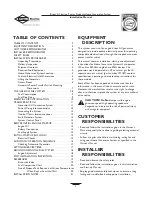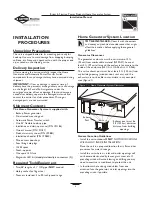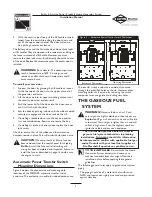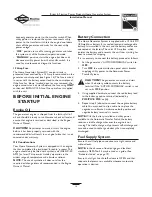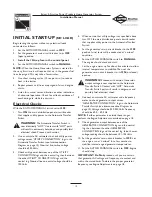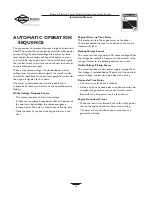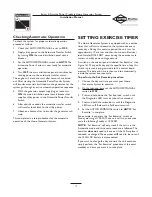
13
Grounding the System
Installer-supplied minimum 10 AWG stranded copper wire
is connected to the generator housing GND lug and routed
through conduit to the Automatic Transfer Switch’s GND
bus. Continue the 10AWG wire through conduit to the
main distribution panel ground bus.Torque all wire
connections/fasteners to values recommended in Figure 15.
Generator grounding rod is used ONLY if required
by local code.
Control Circuit Interconnections
Control circuit interconnections consist of "Utility" and
"Load" leads, plus leads “15”, “205”, and “206”.These seven
signal leads must be routed in conduit that is separate from
the AC power leads. Control lead functions are briefly
described as follows:
• "Utility 1" and "Utility 2" deliver utility power to the
generator’s circuit board.
• "Load 1" and "Load 2" are used to operate the exercise
timer on the generator's circuit board.
• Leads “15”, “205”, and “206” supply control signals to the
Automatic Transfer Switch.
Using installer-supplied minimum 14 AWG stranded copper
wire, connect each control circuit terminal in the generator
to its corresponding terminal in the Automatic Transfer
Switch.Torque all wire connections/fasteners to values
recommended in Figure 15.
Fault Detection System
The light on the control panel is referred to as the
Diagnostic LED. It will turn on and off in a series of blinks if
certain problems are detected in the HGS. An extra LED
and mounting plate is supplied so that it can be installed at a
convenient inside location.The owner will use it to observe
the status of the HGS.
To install the remote LED panel:
• Apply the supplied decal.
• Pull the LED through the mounting plate from the back
until it snaps in place.
• Using minimum 18AWG wire, connect the remote LED
to the generator control panel using supplied pin
connectors. Use wire nuts to attach wire to LED leads.
• Attach mounting plate to installer-supplied low voltage
electrical box.
Refer to the section “Fault Detection System” in the
Owner’s Manual for operation.
System Control Panel
Figure 16 depicts the Home Generator System control
panel, located inside the generator housing. Brief
descriptions of the controls used during installation follow.
More information may be found in the Owner’s Manual.
AUTO/OFF/MANUAL Switch
The most important control on the generator is the
“AUTO/OFF/MANUAL” switch.This three-position
switch will be referred to herein as
“AUTO/OFF/MANUAL”, and is used as follows:
• “AUTO” position is the normal operating position. If a
utility power outage is sensed, the system will start the
generator, let it reach operating temperature, then
Briggs & Stratton Power Products Home Generator System
Installation Manual
Hour Meter
Circuit
Breaker
Set Exercise
Switch
AUTO/OFF/
MANUAL
Switch
Diagnostic
LED
15 Amp
Fuse
Figure 16 — Home Generator System Control Panel
CONNECTIONS:
Torque Value
In Main Distribution Panel:
Minimum
Maximum
Refer to panel manufacturer specs
In Transfer Switch:
UTILITY CONNECTION lugs
35 in-lb
45 in-lb
GENERATOR CONNECTION lugs
35 in-lb
45 in-lb
GND Bar and NEUTRAL Bar:
14-10 AWG
20 in-lb
8 AWG
25 in-lb
6-4 AWG
35 in-lb
Circuit Breakers:
Refer to circuit breaker
manufacturer specs
Figure 15 — Recommended Torque Values


